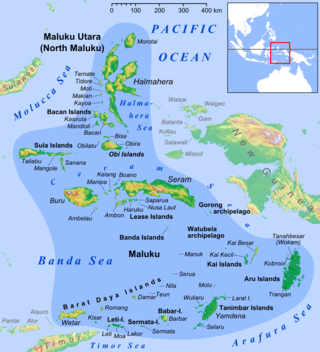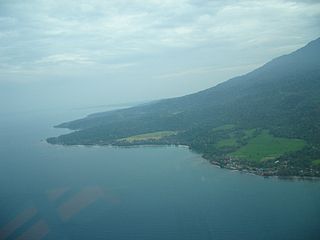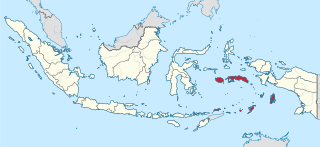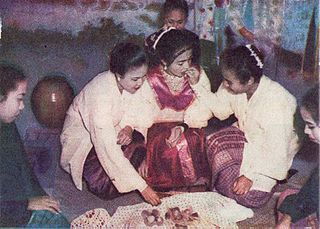| Sula Malay | |
|---|---|
| Sula–Taliabu Malay | |
| Melayu Sula | |
| Native to | Indonesia |
| Region | Sula Islands and Taliabu Island |
Native speakers | 170,000 (2023 estimate) [1] |
Malay-based creole
| |
| Latin | |
| Official status | |
Recognised minority language in | |
| Language codes | |
| ISO 639-3 | – |
| Glottolog | None |
Sula Malay is a variety of Malay-based creole language which is generally used by multiethnic society in Sula Islands and Taliabu Island in the southwest part of North Maluku. The Sula Malay is heavily influenced by other languages, This can be found in loan words originating from Ambonese Malay and Dutch language can be found in Sula Malay. Some contraction vocabulary can also be found in this language, as is the case in North Moluccan Malay (Ternate Malay). [2]
According to 2023 estimate, Sula Malay is spoken by at least 170,000 people in Sula Islands Regency and Taliabu Island Regency as both mother tongue and second language. [1] This language is mainly spoken in Sanana, the capital of the Sula Islands. [2]
Sula Malay has 19 consonants, 5 vowels, and 3 long vowels. Consonant clusters can also be found in Sula Malay, as found in Bacan Malay. The prefixes [man-], [ba(r)-], [pan-], [ta(r)-], and [kase-], as well as the reciprocal prefix [baku-] are also found in this language, which is also similar found in Ternate Malay. Diachronic research results show that Sula Malay has three retention vowels, namely /a/, /i/, and /u/, as well as two vowels resulting from joint innovation, namely /e/ and /o/. [2]

The Maluku Islands or the Moluccas are an archipelago in the eastern part of Indonesia. Tectonically they are located on the Halmahera Plate within the Molucca Sea Collision Zone. Geographically they are located east of Sulawesi, west of New Guinea, and north and east of Timor. Lying within Wallacea, the Moluccas have been considered a geographical and cultural intersection of Asia and Oceania.

The Bacan Islands, formerly also known as the Bachans, Bachians, and Batchians, are a group of islands in the Moluccas in Indonesia. They are mountainous and forested, lying south of Ternate and southwest of Halmahera. The islands are administered by the South Halmahera Regency of North Maluku Province. They formerly constituted the Sultanate of Bacan.

North Maluku is a province of Indonesia. It covers the northern part of the Maluku Islands, bordering the Pacific Ocean to the north, the Halmahera Sea to the east, the Molucca Sea to the west, and the Seram Sea to the south. It shares maritime borders with North Sulawesi, Southeast Sulawesi and Central Sulawesi to the west, Maluku to the south, Southwest Papua to the west, and Palau and the Philippines to the north. The provincial capital is Sofifi on the largest island of Halmahera, while the largest city is the island city of Ternate. The population of North Maluku was 1,038,087 in the 2010 census, making it one of the least-populous provinces in Indonesia, but by the 2020 Census the population had risen to 1,282,937, and the official estimate as at mid 2023 was 1,328,594.

Halmahera, formerly known as Jilolo, Gilolo, or Jailolo, is the largest island in the Maluku Islands. It is part of the North Maluku province of Indonesia, and Sofifi, the capital of the province, is located on the west coast of the island.
In addition to its classical and modern literary form, Malay had various regional dialects established after the rise of the Srivijaya empire in Sumatra, Indonesia. Also, Malay spread through interethnic contact and trade across the south East Asia Archipelago as far as the Philippines. That contact resulted in a lingua franca that was called Bazaar Malay or low Malay and in Malay Melayu Pasar. It is generally believed that Bazaar Malay was a pidgin, influenced by contact among Malay, Hokkien, Portuguese, and Dutch traders.

The Minahasans or Minahassa are an indigenous ethnic group from the North Sulawesi province of Indonesia, formerly known as North Celebes. The Minahasa people sometimes refer to themselves as Manado people. Although the Minahasan pre-Christian creation myth entails some form of ethnic unification, before the nineteenth century the Minahasa region was in no way unified. Instead, a number of politically independent groups (walak) existed together, often in a permanent state of conflict.
Manado Malay, or simply the Manado language, is a creole language spoken in Manado, the capital of North Sulawesi province in Indonesia, and the surrounding area. The local name of the language is bahasa Manado, and the name Minahasa Malay is also used, after the main ethnic group speaking the language. Since Manado Malay is used primarily for spoken communication, there is no standard orthography.

Maluku is a province of Indonesia. It comprises the central and southern regions of the Maluku Islands. The largest city and capital of Maluku province is Ambon on the small Ambon Island. It is directly adjacent to North Maluku, Southwest Papua, and West Papua in the north, Central Sulawesi, and Southeast Sulawesi in the west, Banda Sea, Australia, East Timor and East Nusa Tenggara in the south and Arafura Sea, Central Papua and South Papua in the east. The land area is 57803.81 km2, and the total population of this province at the 2010 census was 1,533,506 people, rising to 1,848,923 at the 2020 census, the official estimate as at mid 2023 was 1,908,753. Maluku is located in Eastern Indonesia.

The Obi Islands are a group of 42 islands in the Indonesian province of North Maluku, north of Buru and Ceram, and south of Halmahera. With a total area of 3,048.08 km2, they had a population of 41,455 at the 2010 Census and 50,760 at the 2020 Census. The official estimate as at mid 2022 was 52,588.

The Ambonese, misunderstood as well as Moluccans, are an ethnic group of mixed Austronesian and Melanesian origin. They are majority Christians followed by Muslims. The Ambonese are from Ambon Island in Maluku, an island group east of Sulawesi and north of Timor in Indonesia. They also live on the southwest of Seram Island; which is part of the Moluccas, Java, New Guinea; on the West Papua side and other regions of Indonesia. Additionally, there are about 35,000 Ambonese people living in the Netherlands. By the end of the 20th century, there were 258,331 Ambonese people living in Ambon, Maluku.

Taliabu Island Regency is a regency in the North Maluku province of Indonesia, consisting primarily of the island of Taliabu, the most western, geographically, of the Sula archipelago. It is located to the west of Mangole Island and Sanana Island, the two islands which remain part of the former Sula Islands Regency; until 14 December 2012, when it was administratively-separated into its own regency, Taliabu had been a part of the Sula Islands Regency. Presently, Taliabu Island Regency covers roughly 1,507.41 km2. Taliabu had a population of 47,309 at the 2010 Census and 58,047 at the 2020 Census; the official estimate as at mid 2023 was 64,885.
Ternate can refer to:
Tidore is a language of North Maluku, Indonesia, spoken by the Tidore people. The language is centered on the island of Tidore, but it is also spoken in some areas of the neighbouring Halmahera. A North Halmahera language, it is unlike most languages in Indonesia which belong to the Austronesian language family. Tidore and other North Halmahera languages are perhaps related to languages of the Bird's Head Peninsula, West Papua.

The Sultanate of Ternate, previously also known as the Kingdom of Gapi is one of the oldest Muslim kingdoms in Indonesia besides the sultanates of Tidore, Jailolo, and Bacan.

Moluccans are the Austronesian-speaking and Papuan-speaking ethnic groups indigenous to the Maluku Islands, Eastern Indonesia. The region was historically known as the Spice Islands, and today consists of two Indonesian provinces of Maluku and North Maluku. As such, "Moluccans" is used as a blanket term for the various ethnic and linguistic groups native to the islands.
Ternate is a language of northern Maluku, eastern Indonesia. It is spoken by the Ternate people, who inhabit the island of Ternate, as well as many other areas of the archipelago. It is the dominant indigenous language of North Maluku, historically important as a regional lingua franca. A North Halmahera language, it is unlike most languages of Indonesia which belong to the Austronesian language family.
North Moluccan Malay is a Malay-based creole language spoken on Ternate, Tidore, Halmahera, and Sula Islands, North Maluku for intergroup communications. The local name of the language is bahasa Pasar, and the name Ternate Malay is also used, after the main ethnic group speaking the language. Since North Moluccan Malay is used primarily for spoken communication, there is no standardized orthography. One of its varieties is Sula Malay, which was formed with the influence of Ambonese Malay and Dutch language.
Sula is a Malayo-Polynesian language of the Central Maluku branch. It is related to the Buru language.
Bacan Malay or Bacan is a Malayic language spoken on the island of Bacan in North Maluku province, Indonesia, by the minor Bacan ethnic group. It is an anomalous presence in the region, being surrounded by genetically distant Austronesian languages and languages of the unrelated North Halmahera family. Bacan is geographically removed from the Malay heartlands in the western archipelago.